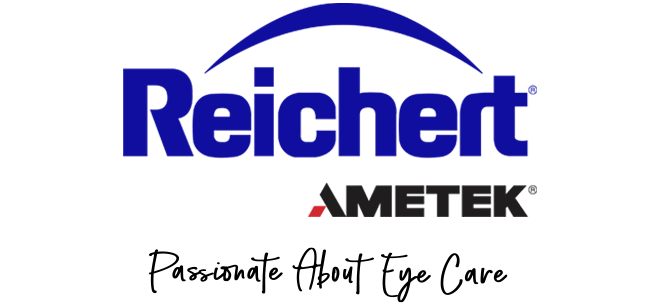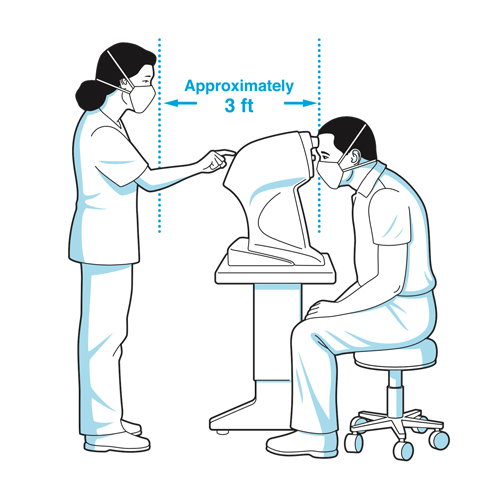自发明非接触式眼压计近 50 年以来,Reichert® 不断创新,并开创了非接触式专利技术,如角膜补偿眼压(IOPcc)和角膜滞后量(CH),前者是一种更好的压力测量方法,后者一直被证明是预测青光眼进展的一个更有力的因素,与青光眼进展密切相关,并且比眼压和 CCT 等关键风险因素更为重要。
如今,眼科护理专家更加关注安全问题,不仅关注患者还关注其员工的安全。关于如何最安全地进行常规眼科检查,特别是在眼压测量方面,一直存在着很多争论。
Reichert 在此回答您关于如何安全使用非接触式眼压计的问题,并提供有关最佳做法的最新信息。根据目前的研究,没有实质性证据表明非接触式眼压测量会产生气溶胶,而且目前的科学表明,通过眼泪传播新冠病毒的风险很低,似乎只限于出现眼部症状的患者。
Reichert 非接触式眼压计需要什么级别的清洁?
所有 Reichert 非接触式眼压计都被归类为非关键设备,因为它们接触的是完好的皮肤,不会接触粘膜。因此,非接触式眼压计需要低水平的消毒。
注意:Goldmann 眼压计和棱镜被归类为半关键设备,需要高水平的消毒。
非接触式眼压计的正确清洁和低水平消毒程序是什么?
| 仪器部件 | 频率 | 清洁和消毒程序 |
| 前额托垫和前挡板 | 在每位患者之后 | 前额托垫和前挡板 用一块软布沾上温和的清洁剂溶液(1 毫升液体洗洁精兑 1 升干净的过滤水 [过滤到 5 微米以下])或用一块无菌的 70% 异丙醇或乙醇酒精擦拭布来清洁仪器的外表面。注意:根据不同的型号和序列号,可以在授权的 Reichert 经销商处购买用于更换的前额托垫。 注意:根据不同的型号和序列号,可以在授权的 Reichert 经销商处购买用于更换的前额托垫。 |
| 外部表面 | 根据需要 | 用一块软布沾上温和的清洁剂溶液(1 毫升液体洗洁精兑 1 升干净的过滤水 [过滤到 5 微米以下])来清洁仪器的外表面。 |
| 操作显示屏 | 根据需要 | 用一块软布沾上温和的清洁剂,或用一块无菌的 70% 异丙醇或乙醇酒精擦拭布来清洁仪器的操作显示屏。 |
| 光学窗口和空气管 | 根据需要 | 需要定期清洁对准和压平光学窗口。空气管也应定期进行清洁。不要用液体来清洁空气管。请查阅用户手册或联系 Reichert 技术支持部门,了解您仪器的具体清洁说明。 |
空气管上的病毒是否有可能传播给其他患者?
没有证据表明,病毒会进入非接触式眼压计的空气管并传播给其他患者。1
非接触式眼压测量是一个产生气溶胶的过程(AGP)吗?
没有实质性证据表明非接触式眼压测量会产生气溶胶。关于这个问题的唯一一篇论文是由 Britt 等人于 1991 年发表的。这些作者使用荧光摄影法,通过补充局部荧光素或人工泪液来捕捉向眼睛吹气时眼睛中的可见泪膜飞溅情况。1 然而,这种摄影方法无法捕捉到“气溶胶”,因为气溶胶是眼睛看不到的颗粒。今天,人们一致认为,作者在描述他们的研究结果时使用了不正确的术语——“微气溶胶”。还应注意的是,研究中所使用的空气脉冲技术比现代非接触式眼压计施加的力大 4 到 6 倍,使得泪膜飞溅的程度更严重。2
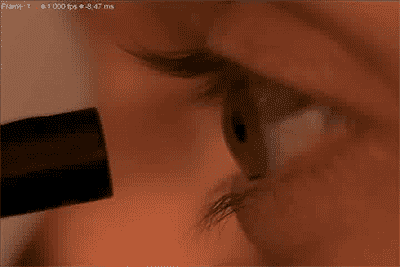 |
目前 Reichert 非接触式眼压计施加的空气脉冲力比前几代产品要温和 6 倍。 |
新冠病毒是否有可能存在于眼泪中?
感染的主要途径是通过口、鼻和肺产生的飞沫进入体内。3 许多研究评估了眼泪中是否存在新冠病毒,发现存在的风险很低(0-5.2%),而且只存在于有眼部症状的患者中,如球结膜水肿、结膜充血或结膜炎。4-6
通过眼睛传播病毒的风险有多大?
有人认为,由于 ACE 受体的存在,眼睛可能是病毒的入口,但目前没有临床证据证明这一理论(而且真皮层也含有 ACE 受体)。7 此外,没有证据表明病毒颗粒可以在非接触式眼压测量过程中被植入眼睛内。Reichert 非接触式眼压计的空气脉冲产生机构几乎完全被仪器的塑料外壳所遮盖,使得患者或临床医生的呼吸道飞沫不可能进入仪器。
是否有证据表明,使用非接触式眼压计会造成病毒传播?
没有,非接触式眼压计有 50 年的安全使用记录。目前还没有关于使用非接触式眼压计造成了病毒传播的记录。
与其他形式的眼压测量相比,非接触式眼压测量是否能使临床医生和患者之间保持一个更安全的工作距离?
是的,临床医生与患者之间的距离一般约为 3 英尺,很少需要临床医生接触眼睑。
 |
点击这里下载可打印的 PDF 文件 关于新冠病毒期间 Reichert 非接触式眼压计是否安全的问答。 |
关于新冠病毒和非接触式眼压计安全问题的近期文章:
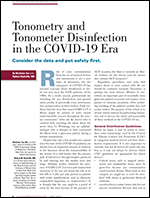 |
“新冠病毒期间的眼压测量和眼压计消毒。”
|
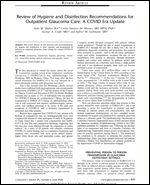 |
“青光眼护理门诊的卫生和消毒建议综述 “ 作者: Julie Shabto, BA, 医学博士、公共健康硕士、博士 Carlos Gustavo De Moraes, 医学博士 George Cioffi 和 Jeffrey M. Liebmann, 《青光眼医学杂志》2020 年 6 月 ”... [无接触式眼压计] 比其他方式更能增大医生和患者之间的距离。” 阅读完整的 PDF 文章 » |
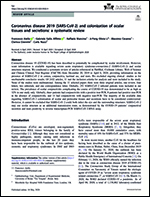 |
“2019 年新冠疫情(新冠病毒)与眼组织和分泌物的定植:系统综述” |
A - Medeiros FA, Meira-Freitas D, Lisboa R, Kuang TM, Zangwill LM, Weinreb RN. 角膜滞后量是青光眼进展的一个风险因素:一项前瞻性的纵向研究.眼科.2013 年 8 月;120(8):1533-40.
B - De Moraes CV, Hill V, Tello C, Liebmann JM, Ritch R. 较低的角膜滞后量与较快的青光眼视野损害进展有关。青光眼杂志.2012 年 4-5 月;21(4):209-13.
C - Susanna CN, Diniz-Filho A, Daga FB, Susanna BN, Zhu F, Ogata NG, Medeiros FA. 美国眼科学杂志.探讨角膜滞后量作为预测青光眼发展的一个风险因素的前瞻性纵向研究.2018 年 3 月;187:148-152. doi: 10.1016/j.ajo.2017.12.018.
1 - Britt JM, Clifton BC, Barnebey HS, Mills RP. 非接触式“吹气”眼压测量中微气溶胶的形成. Arch Ophthalmol. 1991 年 2 月;109(2):225-8. PubMed PMID: 1993032.
2 - Micalla Peng, MS; Nathan M. Radcliffe, MD. Ophthalmology Management, 卷: 24, 期: Glaucoma Physician 2020 年 6 月, 页码: E4-E7.
3 - Carlos WG, Dela Cruz CS, Cao B, Pasnick S, Jamil S. 新型武汉 (2019-nCoV) 冠状病毒. Am J Respir Crit Care Med. 2020 年 2 月 15 日;201(4):P7-P8. doi: 10.1164/rccm.2014P7. PubMed PMID: 32004066.
4 - 评估新冠病毒感染者的眼泪和结膜分泌物中的冠状病毒. Jianhua Xia MM, Jianping Tong MD, Mengyun Liu MM, Ye Shen MD, Dongyu Guo MD. J Med Virol. 2020;16.
5 - 2019 年中国新冠病毒的临床特征. N Engl J Med. 2020 年 2 月 28 日. doi: 10.1056/NEJMoa2002032. Guan WJ 等人.
6 - Seah IYJ, Anderson DE, Kang AEZ, Wang L, Rao P, Young BE, Lye DC, Agrawal R. 评估 2019 年新冠病毒 (COVID-19) 患者的病毒脱落和眼泪的传染性.眼科.2020 年 3 月 24 日. pii: S0161-6420(20)30311-0. doi: 10.1016/j.ophtha.2020.03.026.
7 - Zhou L, Xu Z, Castiglione GM, Soiberman US, Eberhart CG, Duh EJ. ACE2 和 TMPRSS2 在人类眼球表面表达,表明容易感染上新冠病毒.BioRXiv. https://doi.org/10.1101/2020.05.09.086165Â [已提交,未经同行评审]
关于 Reichert Technologies®
Reichert Technologies® 总部位于纽约州布法罗市,是一家为眼科医生、验光师、眼镜商和零售眼保健中心设计、开发和制造高质量诊断设备和器材的全球领先企业。
Reichert 是综合验光仪®、焦度计® 和非接触式眼压计的发明者,延续了 180 年的创新传统,在美国陆续推出了数字综合验光仪® VRx、Tono-Pen® 眼压计、ClearChart® 数字视力系统和眼反应分析仪®,其推出的眼反应分析仪® 是青光眼诊断和治疗方面的一大突破,可以测量角膜滞后量和 IOPcc。
Reichert Technologies® 隶属于 AMETEK, Inc. 的超精密技术部,AMETEK, Inc. 是一家全球领先的电子仪器和机电设备制造商,年销售额约为 50 亿美元。
